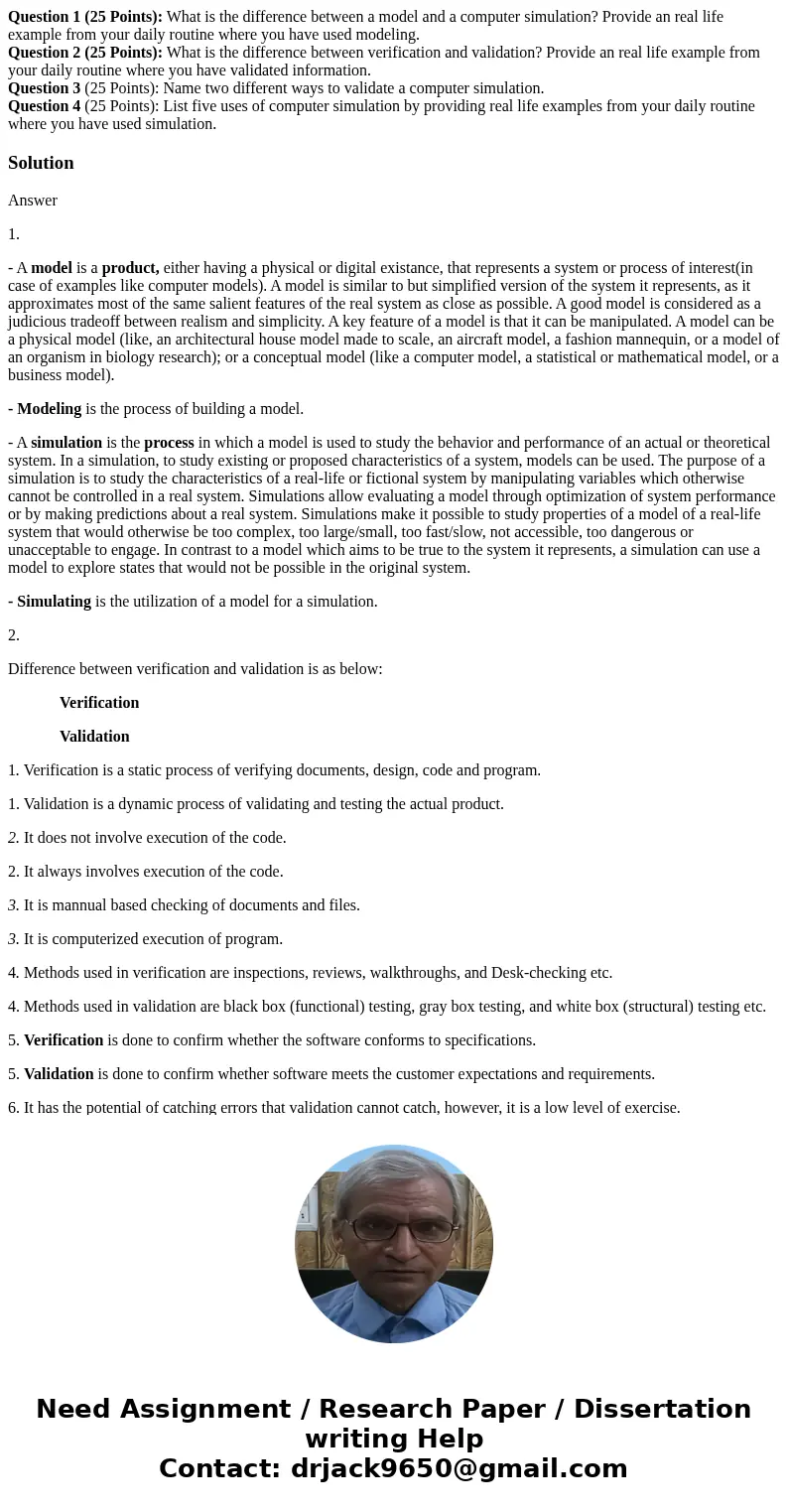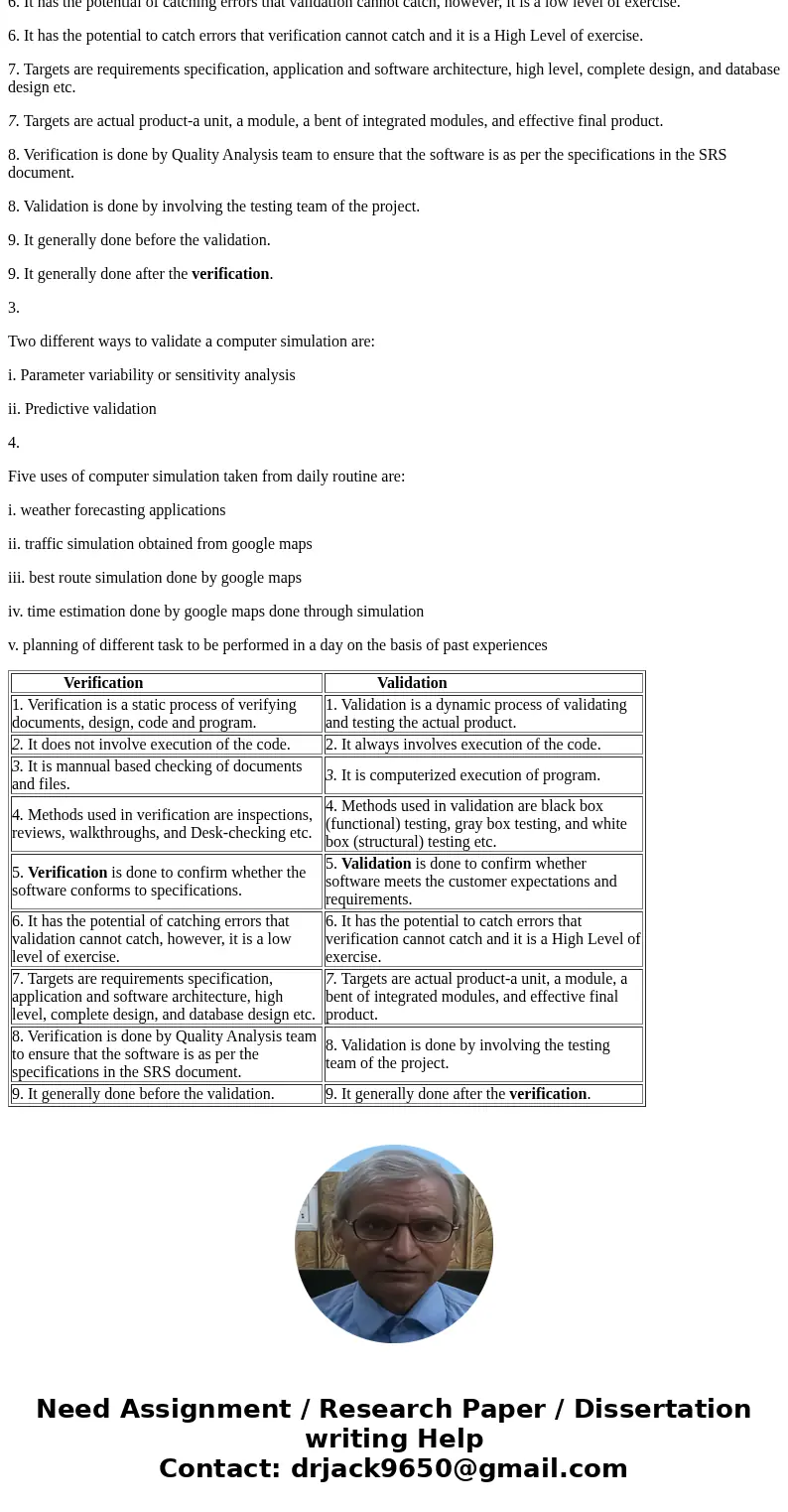Question 1 25 Points What is the difference between a model
Question 1 (25 Points): What is the difference between a model and a computer simulation? Provide an real life example from your daily routine where you have used modeling.
Question 2 (25 Points): What is the difference between verification and validation? Provide an real life example from your daily routine where you have validated information.
Question 3 (25 Points): Name two different ways to validate a computer simulation.
Question 4 (25 Points): List five uses of computer simulation by providing real life examples from your daily routine where you have used simulation.
Solution
Answer
1.
- A model is a product, either having a physical or digital existance, that represents a system or process of interest(in case of examples like computer models). A model is similar to but simplified version of the system it represents, as it approximates most of the same salient features of the real system as close as possible. A good model is considered as a judicious tradeoff between realism and simplicity. A key feature of a model is that it can be manipulated. A model can be a physical model (like, an architectural house model made to scale, an aircraft model, a fashion mannequin, or a model of an organism in biology research); or a conceptual model (like a computer model, a statistical or mathematical model, or a business model).
- Modeling is the process of building a model.
- A simulation is the process in which a model is used to study the behavior and performance of an actual or theoretical system. In a simulation, to study existing or proposed characteristics of a system, models can be used. The purpose of a simulation is to study the characteristics of a real-life or fictional system by manipulating variables which otherwise cannot be controlled in a real system. Simulations allow evaluating a model through optimization of system performance or by making predictions about a real system. Simulations make it possible to study properties of a model of a real-life system that would otherwise be too complex, too large/small, too fast/slow, not accessible, too dangerous or unacceptable to engage. In contrast to a model which aims to be true to the system it represents, a simulation can use a model to explore states that would not be possible in the original system.
- Simulating is the utilization of a model for a simulation.
2.
Difference between verification and validation is as below:
Verification
Validation
1. Verification is a static process of verifying documents, design, code and program.
1. Validation is a dynamic process of validating and testing the actual product.
2. It does not involve execution of the code.
2. It always involves execution of the code.
3. It is mannual based checking of documents and files.
3. It is computerized execution of program.
4. Methods used in verification are inspections, reviews, walkthroughs, and Desk-checking etc.
4. Methods used in validation are black box (functional) testing, gray box testing, and white box (structural) testing etc.
5. Verification is done to confirm whether the software conforms to specifications.
5. Validation is done to confirm whether software meets the customer expectations and requirements.
6. It has the potential of catching errors that validation cannot catch, however, it is a low level of exercise.
6. It has the potential to catch errors that verification cannot catch and it is a High Level of exercise.
7. Targets are requirements specification, application and software architecture, high level, complete design, and database design etc.
7. Targets are actual product-a unit, a module, a bent of integrated modules, and effective final product.
8. Verification is done by Quality Analysis team to ensure that the software is as per the specifications in the SRS document.
8. Validation is done by involving the testing team of the project.
9. It generally done before the validation.
9. It generally done after the verification.
3.
Two different ways to validate a computer simulation are:
i. Parameter variability or sensitivity analysis
ii. Predictive validation
4.
Five uses of computer simulation taken from daily routine are:
i. weather forecasting applications
ii. traffic simulation obtained from google maps
iii. best route simulation done by google maps
iv. time estimation done by google maps done through simulation
v. planning of different task to be performed in a day on the basis of past experiences
| Verification | Validation |
| 1. Verification is a static process of verifying documents, design, code and program. | 1. Validation is a dynamic process of validating and testing the actual product. |
| 2. It does not involve execution of the code. | 2. It always involves execution of the code. |
| 3. It is mannual based checking of documents and files. | 3. It is computerized execution of program. |
| 4. Methods used in verification are inspections, reviews, walkthroughs, and Desk-checking etc. | 4. Methods used in validation are black box (functional) testing, gray box testing, and white box (structural) testing etc. |
| 5. Verification is done to confirm whether the software conforms to specifications. | 5. Validation is done to confirm whether software meets the customer expectations and requirements. |
| 6. It has the potential of catching errors that validation cannot catch, however, it is a low level of exercise. | 6. It has the potential to catch errors that verification cannot catch and it is a High Level of exercise. |
| 7. Targets are requirements specification, application and software architecture, high level, complete design, and database design etc. | 7. Targets are actual product-a unit, a module, a bent of integrated modules, and effective final product. |
| 8. Verification is done by Quality Analysis team to ensure that the software is as per the specifications in the SRS document. | 8. Validation is done by involving the testing team of the project. |
| 9. It generally done before the validation. | 9. It generally done after the verification. |


 Homework Sourse
Homework Sourse